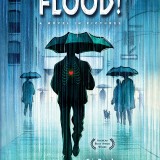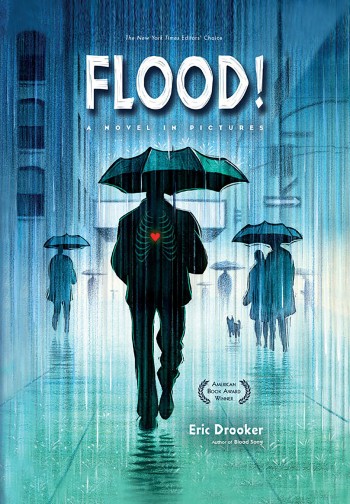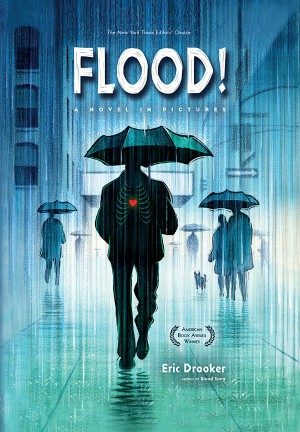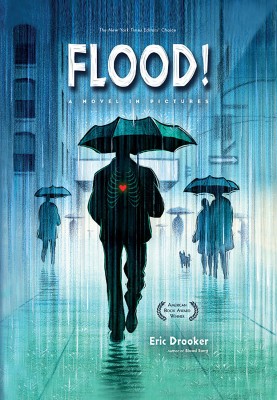
GRAPHIC NOVEL REVIEW: Flood! A Novel in Pictures, Fourth Edition HC
A SILENT REMINDER Independent comic publisher Dark Horse continues its mantra of releasing high class creators-owned graphic novels by releasing FLOOD! A NOVEL IN PICTURES by Eric Drooker last May 2015. Actually, it is fourth edition and printed first time in hardcover. It an introduction by Luc Sante and comprised of four chapters—Home, L, Flood, […]
A SILENT REMINDER
Independent comic publisher Dark Horse continues its mantra of releasing high class creators-owned graphic novels by releasing FLOOD! A NOVEL IN PICTURES by Eric Drooker last May 2015. Actually, it is fourth edition and printed first time in hardcover. It an introduction by Luc Sante and comprised of four chapters—Home, L, Flood, and Interview (with the author). So, what makes this indie classic worth rereading? Here’s why!
First, the fact that “FLOOD!” is reprinted not only the fourth time around but given the deluxe hardcover treatment means something special. Drooker presents us a sort of autobiographical piece of himself in New York in the 1980s. It even won a couple of critically acclaimed comic book awards and undoubtedly being influenced other future and inspiring indie artists as well.
Second, the artwork inside is way different than most creations — Scratchboard. In Drooker’s words, it is “akin to woodcut… subtractive process: the ink was already there, and I scratched it away with razor blade.” Obviously, this is a very tedious artistic methodology indeed! Furthermore, it is a perfectly executed black-and-white (with shades of light blue in the third chapter) and silent (almost wordless) graphic novel, challenging readers to go back and scrutinize the minutest details the creator wants us to see beyond the obvious. Let’s see the chapters.
In Home, we see the sense of alienation, apathy and abandonment in the experiences of the author during the Reagan administration despite claims in adoring history books of the presidency’s accomplishments. Poverty, crime rates, decadence and unemployment are felt in virtually every panel that chronicled Drooker’s life then. The paneling ranges from one-page splashes to the several panels (more than sixteen!) in the last three pages that signify the complete disregard of the government to the welfare of the common folks and the turbulence of many individuals suffered as presented in the last splash page. L is the shortest and this is Drooker’s artistic finest that takes us a journey to one of the most “dangerous” places in New York, the so-called “L” corner street. A voyage in the New York City subways, instead of the terrifying representations, the creator shows his a few moments of artistic and inner liberties/freedoms until the watchman comes along. And the main course and the longest of all, Flood, is what pushed Drooker to the limit of fusing various themes into one cohesive tale of apocalyptic proportions. Simply put, that chapter resonates nowadays of our carelessness, neglect and egoistic view towards the environment as opposed to the simpler and primeval times where many ancient societies treated Mother Nature with great respect and awe. Moreover, in the representation of Drooker himself, the cartoon within the cartoon paneling travels us to some of the most unpleasant American historical events such as slavery, the almost annihilation of the Native Americans, the fight for racial equality, and the decadence of American society via the presentations of several iconic cultural popular references in the midst of serious problems that demand serious solutions. A repeat of historical mistakes in guise of the Roman Empire’s fondness of the carnival is something this book has to offer. And of course, it ends tragically but with a tinge of hope that may symbolize the rejuvenation of the world as we wishfully wish for. The Interview is an adage version but nevertheless, it greatly helps the readers in making sense on the illustrations and symbolisms they may convey the author wants to deliver and the contexts behind these.
Lastly, the book has a very good binding—sturdy and sewn. Turning the pages is another reason this hardcover edition is a plus to serious graphic novel collection. I had a pleasant reading experience due to the excellent binding though some finger-weighted moments to the very few pages. The cover art encapsulates the isolationist and apathetic message point on. The color red in the heart is the only thing left that humanity should look upon. This is rich in symbolisms from start to finish. And, it has a number of additional illustrations that may help understanding Drooker’s overall visions.
My only jabs here are the lack of paginations and annotations to further enhance our comprehension with this book. Probably, there are things that should be left to our own interpretations. Some readers may end up reading this multiple times to grasp the complexities behind the meanings Drooker tries to bring out. Sometimes, the pacing is a bit erratic, particularly in the first and third chapters. Most probably, life in New York City is not as fast pacing as we are informed with. And, as most with serious independent works, mature themes like sex and violence are graphically presented here. Please be warned.
FLOODS! A NOVEL IN PICTURES may be old but its continuing relevance continues to grow as it reminds us the consequences of environmental neglect, the social apathy towards corporate greed and social justice, repeating the mistakes of our past, and the possibilities of stretching the limits of crafting a fine work of graphic illustrative narrative. It simply reads better as the time passes by. DIG IN!
















